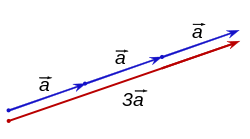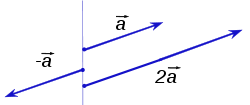Scalar multiplication


In mathematics, scalar multiplication is one of the basic operations defining a vector space in linear algebra[1][2][3] (or more generally, a module in abstract algebra[4][5]). In an intuitive geometrical context, scalar multiplication of a real Euclidean vector by a positive real number multiplies the magnitude of the vector without changing its direction. The term "scalar" itself derives from this usage: a scalar is that which scales vectors. Scalar multiplication is the multiplication of a vector by a scalar (where the product is a vector), and must be distinguished from inner product of two vectors (where the product is a scalar).
Definition
In general, if K is a field and V is a vector space over K, then scalar multiplication is a function from K × V to V. The result of applying this function to c in K and v in V is denoted cv.
Properties
Scalar multiplication obeys the following rules (vector in boldface):
- Additivity in the scalar: (c + d)v = cv + dv;
- Additivity in the vector: c(v + w) = cv + cw;
- Compatibility of product of scalars with scalar multiplication: (cd)v = c(dv);
- Multiplying by 1 does not change a vector: 1v = v;
- Multiplying by 0 gives the zero vector: 0v = 0;
- Multiplying by −1 gives the additive inverse: (−1)v = −v.
Here + is addition either in the field or in the vector space, as appropriate; and 0 is the additive identity in either. Juxtaposition indicates either scalar multiplication or the multiplication operation in the field.
Interpretation
Scalar multiplication may be viewed as an external binary operation or as an action of the field on the vector space. A geometric interpretation of scalar multiplication is that it stretches, or contracts, vectors by a constant factor.
As a special case, V may be taken to be K itself and scalar multiplication may then be taken to be simply the multiplication in the field.
When V is Kn, scalar multiplication is equivalent to multiplication of each component with the scalar, and may be defined as such.
The same idea applies if K is a commutative ring and V is a module over K. K can even be a rig, but then there is no additive inverse. If K is not commutative, the distinct operations left scalar multiplication cv and right scalar multiplication vc may be defined.
See also
References
- ↑ Lay, David C. (2006). Linear Algebra and Its Applications (3rd ed.). Addison–Wesley. ISBN 0-321-28713-4.
- ↑ Strang, Gilbert (2006). Linear Algebra and Its Applications (4th ed.). Brooks Cole. ISBN 0-03-010567-6.
- ↑ Axler, Sheldon (2002). Linear Algebra Done Right (2nd ed.). Springer. ISBN 0-387-98258-2.
- ↑ Dummit, David S.; Foote, Richard M. (2004). Abstract Algebra (3rd ed.). John Wiley & Sons. ISBN 0-471-43334-9.
- ↑ Lang, Serge (2002). Algebra. Graduate Texts in Mathematics. Springer. ISBN 0-387-95385-X.
| ||||||||||||||||||||||||||